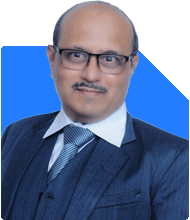Ramalingam Kalirajan |10893 Answers |Ask -Follow
Mutual Funds, Financial Planning Expert - Answered on Jul 02, 2024
He has an MBA in finance from the University of Madras and is a certified financial planner.
He is the director and chief financial planner at Holistic Investment, a Chennai-based firm that offers financial planning and wealth management advice.... more

Sir mujhe 10 lakh rs lumsum investment karna hai for 10 years, kin mutual funds me invest Karu or kaise Karu..?
Congratulations on deciding to invest a substantial amount for your future. This shows your commitment to growing your wealth and achieving financial security.
Understanding Mutual Funds
Mutual funds pool money from multiple investors to invest in a diversified portfolio of stocks, bonds, or other securities. They are managed by professional fund managers who aim to achieve the best possible returns for investors.
Advantages of Mutual Funds
Professional Management: Fund managers have the expertise to make informed investment decisions.
Diversification: Mutual funds spread investments across various securities, reducing risk.
Liquidity: You can easily buy and sell mutual fund units.
Tax Efficiency: Certain mutual funds offer tax benefits under Section 80C of the Income Tax Act.
Power of Compounding: Reinvesting returns can significantly grow your investment over time.
Types of Mutual Funds
1. Equity Mutual Funds:
Equity funds invest in stocks and have the potential for high returns. They are suitable for long-term goals like your 10-year investment horizon. These funds are ideal for investors with a higher risk tolerance.
2. Debt Mutual Funds:
Debt funds invest in fixed-income securities like bonds. They provide stable returns with lower risk compared to equity funds. Including debt funds in your portfolio can help balance risk and provide steady income.
3. Hybrid Mutual Funds:
Hybrid funds invest in a mix of equity and debt. They offer a balanced approach, providing growth potential and stability. These funds are suitable for investors seeking moderate risk and returns.
4. Sectoral/Thematic Funds:
Sectoral or thematic funds invest in specific sectors or themes like technology, healthcare, or infrastructure. These funds can offer high returns but come with higher risk. They are suitable for knowledgeable investors who can handle sector-specific risks.
5. Index Funds:
Index funds replicate the performance of a specific index like Nifty 50 or Sensex. While they offer diversification and lower expense ratios, they might not always provide the best returns compared to actively managed funds.
Why Not Index Funds?
Index funds simply track the market and do not aim to outperform it. They might not provide the best returns in different market conditions. Actively managed funds, on the other hand, have professional managers who adjust the portfolio based on market trends, offering potential for higher returns.
Systematic Investment Plan (SIP) vs. Lump Sum
While you have a lump sum to invest, it’s worth considering a Systematic Investment Plan (SIP) for a portion of the amount. SIP allows you to invest a fixed amount regularly, reducing market timing risks and benefiting from rupee cost averaging.
Investment Strategy for Rs. 10 Lakh
1. Diversify Your Portfolio:
Allocate your investment across different types of mutual funds to balance risk and returns. Here’s a suggested allocation:
Equity Funds (60%): Rs. 6 lakh
Include a mix of large-cap, mid-cap, and small-cap funds.
Debt Funds (30%): Rs. 3 lakh
Invest in short-term and long-term debt funds for stability.
Hybrid Funds (10%): Rs. 1 lakh
Choose a balanced fund for moderate growth and stability.
2. Selecting the Right Funds:
Choose funds with a good track record and consistent performance. Look for funds managed by reputable asset management companies. Evaluate the fund manager’s expertise and the fund’s performance across different market cycles.
3. Regular Review and Rebalancing:
Review your portfolio regularly, at least once a year. Rebalance your investments to maintain the desired asset allocation. If equity markets perform well, the proportion of equity funds in your portfolio might increase. Rebalancing ensures you stick to your risk tolerance.
4. Emergency Fund:
Before investing, ensure you have an emergency fund covering 6-12 months of expenses. This fund should be kept in a liquid form like a savings account or liquid mutual funds. An emergency fund provides a safety net for unexpected financial challenges.
5. Life and Health Insurance:
Ensure you have adequate life and health insurance coverage. This protects your family’s financial future and covers medical expenses. Opt for term insurance for life cover and a comprehensive health insurance policy.
6. Tax Planning:
Invest in tax-saving mutual funds (ELSS) if you need to reduce your taxable income. ELSS funds offer tax benefits under Section 80C and have a lock-in period of three years. They also provide the potential for high returns due to equity exposure.
7. Estate Planning:
Plan for the distribution of your assets to ensure your family’s financial security. Create a will to specify how your assets should be distributed among heirs. Setting up trusts can help in managing and protecting your wealth.
Final Insights
Investing Rs. 10 lakh for 10 years can significantly grow your wealth if done wisely. Here’s a summary of the key steps you should take:
Diversify: Invest in a mix of equity, debt, and hybrid mutual funds.
Professional Management: Choose funds managed by reputable fund managers.
SIP and Lump Sum: Consider splitting your investment between lump sum and SIP.
Emergency Fund: Maintain an emergency fund covering 6-12 months of expenses.
Insurance: Ensure adequate life and health insurance coverage.
Regular Review: Regularly review and rebalance your portfolio.
Tax Planning: Invest in tax-saving mutual funds if needed.
Estate Planning: Plan for the distribution of your assets.
By following these steps and regularly reviewing your financial plan with a Certified Financial Planner, you can achieve your investment goals and secure a comfortable future. Your disciplined approach and proactive decision-making will help you build a strong financial foundation.
Best Regards,
K. Ramalingam, MBA, CFP,
Chief Financial Planner,
www.holisticinvestment.in
You may like to see similar questions and answers below
Ramalingam Kalirajan |10893 Answers |Ask -Follow
Mutual Funds, Financial Planning Expert - Answered on Feb 10, 2024
Ramalingam Kalirajan |10893 Answers |Ask -Follow
Mutual Funds, Financial Planning Expert - Answered on Jul 15, 2024
Milind Vadjikar | Answer |Ask -Follow
Insurance, Stocks, MF, PF Expert - Answered on Nov 25, 2024
Ramalingam Kalirajan |10893 Answers |Ask -Follow
Mutual Funds, Financial Planning Expert - Answered on Nov 03, 2025
Ramalingam Kalirajan |10893 Answers |Ask -Follow
Mutual Funds, Financial Planning Expert - Answered on Nov 03, 2025
Nitin Narkhede |113 Answers |Ask -Follow
MF, PF Expert - Answered on Dec 15, 2025
Nitin Narkhede |113 Answers |Ask -Follow
MF, PF Expert - Answered on Dec 15, 2025
Ramalingam Kalirajan |10893 Answers |Ask -Follow
Mutual Funds, Financial Planning Expert - Answered on Dec 15, 2025
Ramalingam Kalirajan |10893 Answers |Ask -Follow
Mutual Funds, Financial Planning Expert - Answered on Dec 15, 2025
Radheshyam Zanwar |6746 Answers |Ask -Follow
MHT-CET, IIT-JEE, NEET-UG Expert - Answered on Dec 15, 2025
Ramalingam Kalirajan |10893 Answers |Ask -Follow
Mutual Funds, Financial Planning Expert - Answered on Dec 15, 2025
Ramalingam Kalirajan |10893 Answers |Ask -Follow
Mutual Funds, Financial Planning Expert - Answered on Dec 15, 2025
Ramalingam Kalirajan |10893 Answers |Ask -Follow
Mutual Funds, Financial Planning Expert - Answered on Dec 15, 2025
Samraat Jadhav |2508 Answers |Ask -Follow
Stock Market Expert - Answered on Dec 15, 2025
Ramalingam Kalirajan |10893 Answers |Ask -Follow
Mutual Funds, Financial Planning Expert - Answered on Dec 15, 2025


























